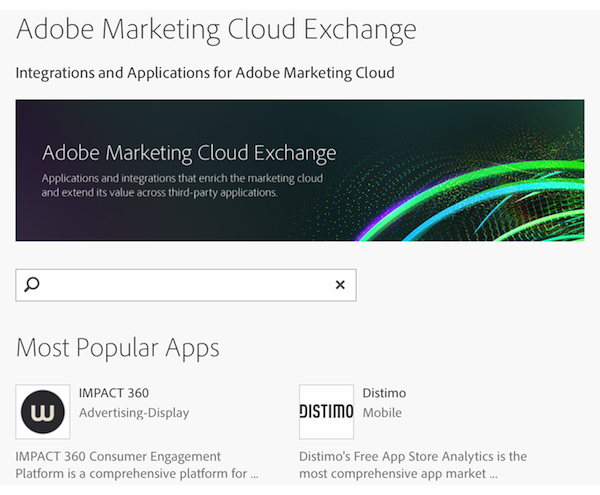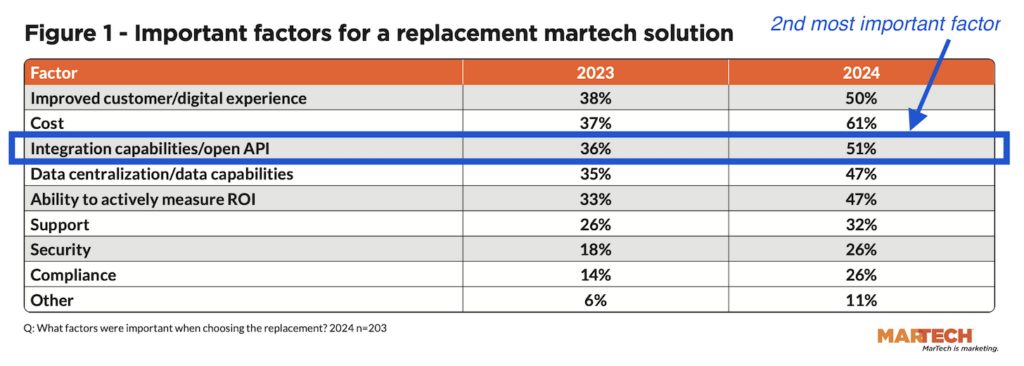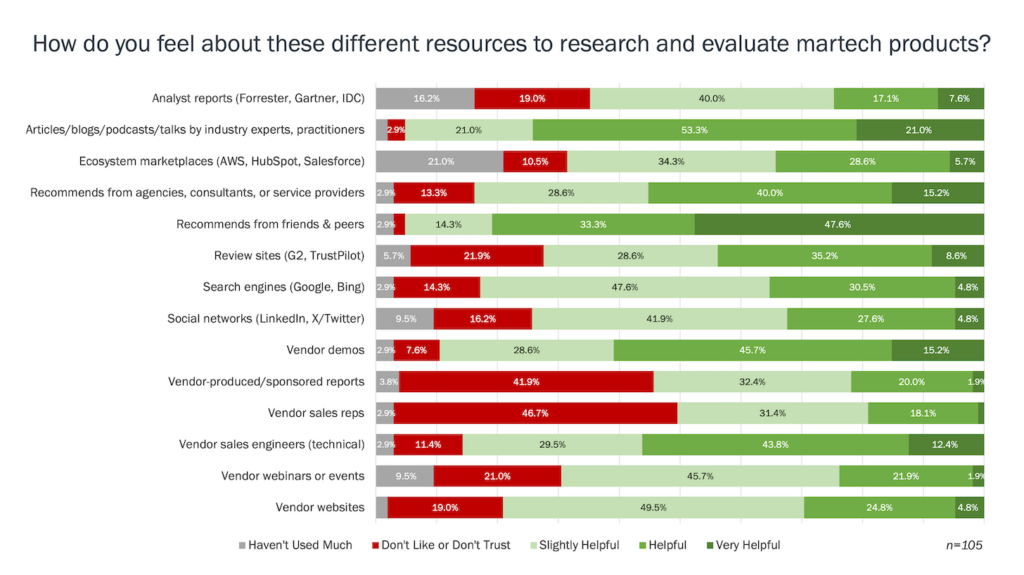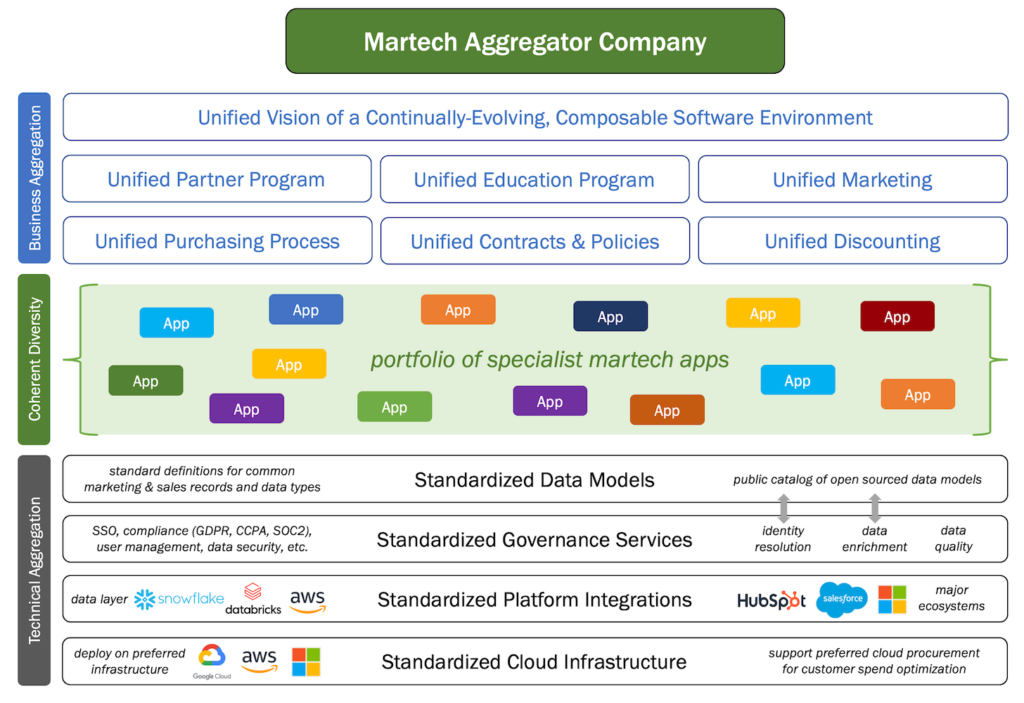The battle of the marketing clouds is heating up.
Last month Oracle announced its unified Oracle Marketing Cloud, and yesterday IBM introduced ExperienceOne — both massive visions of how all the different acquisitions they’ve made in the marketing space will be stitched together into more cohesive offerings.
But with all these proclamations of marketing technology nirvana, I have one overriding criterion that I look for: do they embrace an open model for third-party marketing applications? Who will be the next major marketing cloud to challenge Marketo’s open platform strategy?
The winner: Adobe.
Yesterday, Adobe unveiled its Marketing Cloud Exchange, an app-like store of third-party products that can be easily integrated into Adobe’s Marketing Cloud infrastructure, at least at a core data level.
They’re launching with more than 150 apps in their exchange, which has apparently already been leveraged by more than 1,200 major brand customers worldwide in an extensive beta program.
To quote the blog post from Suresh Vittal, VP of marketing strategy for Adobe’s digital marketing business, “A big part of getting to the point where a company is realizing the promise of digital marketing is to democratize their critical marketing data across products and platforms.” (Emphasis added is mine.)
This is not a we do everything you would ever want in digital marketing position. This is a position that acknowledges that third-party innovation is a critical part of digital marketing — that a 1,000 innovators of marketing technology can be an incredible source of strength. This is a we can be the foundation of everything you would ever want in digital marketing position.
A subtle, but incredibly important, distinction.
More from Suresh: “The Adobe Marketing Cloud Exchange Program is the most effective way for Adobe’s partners to leverage their resources to build reusable integrations with Adobe Marketing Cloud and make those integrations discoverable and available to Marketing Cloud customers.” (My emphasis on discoverable — since that’s the difference between third-parties in the parlor vs. third-parties in the basement.)
Now, let me acknowledge that almost all major marketing clouds — or as I’ve called them, marketing backbone platforms — have some degree of openness. Salesforce’s CRM has been a paragon of an open platform strategy. ExactTarget, which has become part of the Salesforce marketing cloud, has their HubExchange (although it’s recently been demoted off a prime position on their home page). IBM has their Digital Data Exchange (DDX). Oracle has the Eloqua AppCloud. Although for these last two, it’s worth noting that neither were mentioned in IBM’s and Oracle’s latest press releases on their marketing cloud visions.
It’s a difference as to whether they look at an open ecosystem as a major part of their strategy, which they prominently tout in their marketing and sales — or whether such integrations are treated more as back-office wiring or a “check the box” kind of openness.
Since strategy sets priorities, and priorities have a real effect on the engineering evolution of software products, this isn’t just a matter of semantics. It signals the intentions of how these platforms intend to progress. And that signaling will have an effect on customer acquisition and third-party developer support.
I think this is a brilliant move on Adobe’s part — and a great step forward for our industry.
Now let’s see how Adobe and Marketo follow through on their open platform visions. And who follows next.
By the way, if you’re interested in a vendor neutral discussion of marketing cloud strategies, I’d highly encourage you to consider attending MarTech: The Marketing Tech Conference this August in Boston.
Travis Wright will be giving a terrific presentation on To Build or Buy Your Own Marketing Cloud.
David Raab will be sharing his insights on How to Align Marketing Technology with Business Strategy.
And there will be more than a dozen other renown marketing technology analysts and practitioners speaking on leading edge topics of marketing technology management.
UPDATE: David Raab, who suggested crowdsourcing a standard by which we could measure the “platformality” of different marketing clouds, has written a terrific post on this subject: What Makes a Good Marketing Platform? Rules for Platformality.





I’m not sure the question is what marketing platform provider is stepping up to challenge Marketo. I don’t know that IBM, Adobe or Oracle necessarily care to do that. The “open platform” solution is best suited for the SMB market – not the size and complexity of many of the companies “the majors” sell into. I think a better question is, how are the big marketing platforms opening up to work with the third-party vendor integration their clients want?
In that way, Adobe’s Marketing Cloud Exchange is really interesting. It’s basically a highly productized (perhaps monetized?) version of their prior partner network, which itself is similar to IBM’s Digital Marketing Network. AppCloud and HubExchange are similar too, but are much smaller-scale and not as integrated into core digital analysis.
Hi, Blair.
I agree that this isn’t a black-and-white issue: openness and third-party ecosystem support is a highly qualitative feature that almost all vendors in this space have to a greater or lesser degree.
But I do think the degree matters. A lot. And it’s as much a function of the prominence of that “open” message in a vendor’s marketing and sales positioning as it is the underlying technical mechanisms to facilitate data exchange.
Adobe’s launch of their Marketing Cloud Exchange, and the way that Suresh Vittal framed its announcement in his blog post, strikes me as a notable shift towards an open platform position vs. an “it’s all in the box” position with third-party support mentioned as a technical footnote. We’ll have to see where they take it from here — for instance, it would be nice to see that more prominently featured in their Marketing Cloud website — but I’m optimistic by nature.
Perhaps you’re right that the “app store” metaphor implies more of an SMB focus. But Salesforce did a pretty good job with their app exchange in enterprise-class CRM. And given the number of large enterprises that I’ve seen adopt Marketo, they’re not exactly out of that race either.
Let me add: I think IBM has an amazing portfolio of marketing technology. I think your vision for ExperienceOne is grand and beautiful — but I’d be a lot more excited about it if there was greater emphasis on it serving as an open platform for a broader ecosystem of marketing technologies beyond your own portfolio.
All fair points. It sounds like the “discoverable” aspect (i.e. the app store model) of third-party partners is the key difference. That’s clearly valuable to the partners – I wonder if it’ll be so to clients as well? Probably depends on the actual details of the specific integration that David mentioned below.
Hi Scott. I think we need to take the analysis to the next level by defining what it takes to be an “open platform” on the technical level and then rating the vendors appropriately. This probably comes down to what specific API functions are needed, with some related questions about degree of documentation, certification processes / barriers, financial arrangements, etc. Although it’s interesting to see how different vendors position themselves in relation to being a platform, that probably has as much to do with the cleverness of their marketers as their actual business strategies.
Incidentally,we also need a word for “being a platform”…platforminess? platformosity? platformishness?
Never mind that second point — obviously the right word is “platformality” (adj., “the degree to which a system meets the formal requirements of being a platform”). I promise I’ll write a blog post on this at some point.
Platformality. Nice.
Yes! You’re absolutely right.
While there is inherently some relationship between strategy, marketing, and product, the way I’ve been going about it is not a particularly scientific way of measuring the strength of a marketing cloud’s “platformosity” (that gets my vote).
Would be good to brainstorm some of the criteria that should factor into such a metric:
– are data APIs one-way or two-way?
– how limited or complete are those data APIs?
– are there APIs for processes, not just data?
– is there a way to interface into a centralized UI?
– how do third-party developers rate those APIs?
– how do customers rate the ease of third-party integration?
– is there a prominent “app store” of third-party solutions?
Other suggestions?
I’m thinking that the criteria must be quite specific to be useful. (This will quickly lead to specification of use cases, but I’m not there yet.) Top of my head for what platform APIs must let external systems do:
– submit customer identifiers (name, email, etc.) and receive standard ID plus other information (profile details, interaction history, etc.)
– add a new customer (submit identifiers, check for existing match, add new record if not)
– update existing customer data / history
– request a predictive model score (implies other things such as return a list of available scores, create a new model, etc.)
– request a product or treatment recommendation (implies returning the actual content, storing the treatment history, capturing and storing the outcome)
– execute a treatment (actually sending a message via the platform or another associated application; again implies providing content, storing history, capturing results)
– subscribe to changes in a customer profile (i.e., alerts or triggers; again, implies details for how to specify the changes to be identified)
– extract lists (quite different from working with single records as described above; opens a whole line of discussion about volume, speed, etc.)
– reading and modifying business rules for customer treatments (includes campaign rules, contact limits, etc.)
I’m sure there are plenty others. I’d be interested to hear what people who actually build these sorts of apps find they need. Again, it really will come down to use cases.
Sounds like a great beginning to the “Raab Platformality Index”.
Here’s a thought: maybe we could crowdsource this at the MarTech conference?
Great question Scott and David on the criteria of a truly open API and platform. Since our marketing platform team at Lyris is engaged precisely on that issue, may I suggest the following additions to your list of criteria. Namely, there are many more categories of requirements for true openness. The examples in the article and specific API functions you mention are great but focus on marketplaces as the primary manifestation of an open platform.
I would additionally consider the following as being key requirements of open marketing APIs and platforms
* Enable not just data exchange and marketing execution but also make it easier to embed the marketing platform inside the client’s or partner’s custom applications (think for example of UI components and frameworks provided as part of the platform)
* Access and work with customer and enterprise data where it lives – in the cloud or in the enterprise – instead of requiring all data to be moved into the platform first
* Access and work with marketing content where it lives instead of requiring it to be created and managed from within the platform
* Obey open standards rigorously, including standard authentication methods instead of requiring the use of the vendor’s proprietary methods
* Provide ease of use, come with complete documentation, support, and a developer community forum
A truly open API needs to extend to how the application is architected. When an API is “tagged on” instead of built from the ground up via an “API-first” approach, the functionality often isn’t complete and doesn’t represent the most scalable way of operationalizing the value of the platform. That leaves all power in the vendor’s development team instead of truly democratizing access to partners and customers.
To close with a zinger: Apps and a marketplace can be a poor substitute and mask for an API that is actually hard to use. Delivering a “marketplace” of closed apps is not the same as creating an open platform, especially if the API is hard to use. If you compare the requirements above to the solutions mentioned in this blog post, I think it suggest that the market place is still in need of marketing platform solutions that are truly flexible and open.
100% agreed with the points that you have been making for a long time on this site that the “we-do-it-all” suite approach cannot keep up with the quirky, unpredictable, and explosive growth of marketing innovation. Just see your marketing technology landscape as proof!
Akin
Lyris
Akin, thanks for the very thoughtful contribution. I’m not sure how to get the master list built but do think it’s an important project, so will keep banging away. Your comment above is now stored in a new folder on my hard drive.